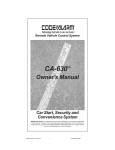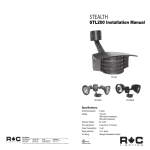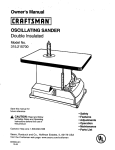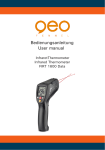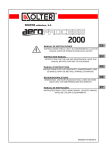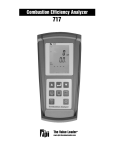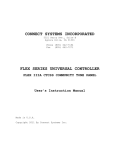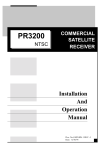Download Code Alarm CA-630 Programming instructions
Transcript
CA-630 Installation Instructions PROFESSIONAL INSTALLATION STRONGLY RECOMMENDED Installation Precautions: Roll down window to avoid locking keys in vehicle during installation Avoid mounting components or routing wires near hot surfaces Avoid mounting components or routing wires near moving parts Tape or loom wires under hood for protection and appearance Use grommets when routing wires through metal surfaces Use a voltmeter for testing and verifying circuits Technical Support For Authorized Dealers - (800) 421-3209 FCC COMPLIANCE This device complies with Part 15 of the FCC rules and with RSS-210 of Industry Canada. Operation is subject to the following two conditions: 1. This device may not cause harmful interference, and 2. This device must accept any interference received, including any interference that may cause undesired operation. Warning! Changes or modifications not expressly approved by the party responsible for compliance could void the user’s authority to operate the equipment. 1 CA 630 install revB 8-04.pmd 1 8/23/2004, 9:22 AM System Layout FOR MODULE FUSE SIZE AND POLARITY LOCATIONS, REFER TO CHART ON PAGE 17. IMPORTANT!!! The module MUST be programmed before it will operate. Refer to the programming instructions on pages 15-18. System Layout CA-630TM A = Advanced Harness B = Basic Harness C = Car Start Harness Note: The wire connection sections will identify each wire with a number (pin cavity) and a letter (harness), i.e.: 20/B = Wire 20, B (Basic) Harness. View from wire end: 1 2 10 11 3 12 4 5 13 6 7 8 9 1 2 3 4 5 14 15 16 13 14 15 16 17 18 6 7 10 11 12 1 2 19 20 21 22 23 24 8 9 7 8 PATS/VATS HARNESS 1 3 2 4 3 Advanced Harness Basic Harness 1. Lock Switch (87a) (BLU/BLK) 1. Parking Light Output (WHITE) 2. Unused 2. Lock Motor Output (BLUE) 3. UnlockSwitch(87a)(GRN/BLK) 3. Dome Light Output (BLK/WHT) 4. Unused) 4. Battery (+12v) (RED) 5. 6. 7. 8. 9. 10. 11. 12. 13. 14. 15. 16. Unused Unused Unused Unused Trunk Switch (87a) (TAN/RED) Unused AUX 2 (-) 500ma (BLU/WHT) Unused Unused ArmedOutput(-)(ORANGE) Unused Unused 5. 6. 7. 8. 9. 10. 11. 12. 13. 14. 15. 16. 17. 18. 19. 20. 21. 22. 23. 24. 6 10 4 Car Start Harness 1. HVAC2Input(+)(BLUE) 2. Battery (+12v)(RED) 3. Ignition2Output(+)(PK/WHT) 4. HVAC1Output(+)(ORG) Ground (BLACK) 5. HVAC2OutpuT(+)(ORG/WHT) Starter Key (+) (VIOLET/RED) 6. Unused Ignition 1 Input/Output (+) (PINK) 7. Brake Input(+) (BROWN) Starter Motor (+) (VIOLET) 8. Neutral Safety (BLK/WHT) Unused 9. Tach In (VIOLET/WHT) Door Trig 10k Pull-up (YELLOW/WHT) 10. Active Out (-) (BLU/BLK) External StartTrigger (WHT/BLU) Unused TrunkMotorOutput(TAN) UnlockMotorOutput(GREEN) Unused Horn/SirenOutput(BLACK) Disarm/OverrideButton(Ground)(PLUGIN) Disarm/OverrideButtonInput(PLUGIN) HoodPinInput(GRAY) DoorTriggerInput(GRN/VT) FactoryAlarmDisarm(-)(BRN/BLK) LED 2 (Red) (PLUGIN) LED 1 (Black) (PLUG IN) SecondDoorUnlock(-)500ma(BLU/GRN) 2 CA 630 install revB 8-04.pmd 5 9 2 8/23/2004, 9:22 AM 1. Basic Harness (B) IMPORTANT!!! • Remove fuses from Module before installation. • Solder and tape all connections. 1/B Parking Light Output +/- (16 AWG) (WHITE) Locate the vehicle parking light wire. Verification: This wire will register either positive voltage or ground when the parking lights are turned on. Voltage does not vary when dimmer switch is adjusted. Refer to the Vehicle Wire Color and Location Chart for the wire color, polarity, and location. Connect the 1/B wire to the parking light wire. IMPORTANT! After installation, set the polarity of this circuit by moving the fuse inside of the control module to positive (+) or negative (-). 2/B Lock Motor Wire (16 AWG) (BLUE) 1/A Lock Switch Wire 87A (16 AWG) (BLUE/BLACK) 14/B Unlock Motor Wire (16 AWG) (GREEN) 3/A Unlock Switch Wire 87A (16AWG) (GREEN/BLACK) 24/B Second Door Unlock (16 AWG -) (BLUE/GREEN) IMPORTANT! After installation, set the polarity of this circuit by moving the fuse inside of the control module to positive (+) or negative (-). Type 1: Positive 3-wire door lock system Polarity Fuse = Positive (+) Single-stage unlock Diagram 1 Connect the 2/B wire to the vehicle lock wire. Fused + 12v Connect the 14/B wire to the vehicle unlock wire. Two-stage unlock 24/B Connect the 2/B wire to the vehicle lock wire. Use a SPDT relay (not supplied) and connect the 24/B wire to the relay as shown in Diagram 1. 86 87 85 87a 30 To vehicle unlock wire 3 CA 630 install revB 8-04.pmd 3 8/23/2004, 9:22 AM 1. Basic Harness (B), cont’d Refer to Diagram 2 to connect to the vehicle’s drivers unlock wire. Diagram 2 Wires from control module 14/B 3/A Unlock Motor Unlock Switch X Cut From driver’s Door Unlock Relay only To driver’s Door Motor only Type 2: Positive 5-Wire Door Lock System Polarity fuse = Positive (+) Single-Stage Unlock Diagram 3 Unlock Motor 14/B Unlock Switch 3/A Lock Motor 2/B Lock Switch 1/A LOCK To Door Lock Motors Vehicle Master Switch UNLOCK Two-Stage Unlock Connect wires 2/B, 1/A as shown in Diagram 3 (above). Use a SPDT relay ( Not Supplied) and connect the 24/B wire to the vehicle’s unlock wire as shown in Diagram 4 (below). Connect wires 14/B, 3/A as shown in Diagram 2 (above). Diagram 4 Fused +12v 86 24/B 87 85 87a 30 From Door Unlock Switch or Relay X To Door Unlock Motor 4 CA 630 install revB 8-04.pmd 4 8/23/2004, 9:22 AM 1. Basic Harness (B), cont’d Type 3: Negative 3-Wire Door Locking System Polarity Fuse = Negative Single-stage unlock Connect the 2/B wire to the vehicle lock wire. Connect the 14/B wire to the vehicle unlock wire. Two-stage unlock Connect the 2/B wire to the vehicle lock wire. Connect the 24/B wire to the vehicle unlock wire. Use a SPDT relay (not supplied) and refer to Diagram 5 to connect to the vehicle’s driver’s unlock wire. Diagram 5 Fused + 12v Fused + 12v 86 85 87 14/B 87a 30 From Driver’s Door Only Unlock Switch or Relay To Driver’s Door Unlock Motor X Cut Here Type 4: Vacuum Door Lock System Polarity Fuse = Positive Note: Two-stage unlock will not work with this type of system. Diagram 6 86 2 / B Lock Motor 3 / A Unlock Switch 87 85 87a 30 14 / B Unlock Motor Master Vehicle Door Lock Switch or Plunger To Control Pump LOCK X Cut Here UNLOCK 5 CA 630 install revB 8-04.pmd 5 8/23/2004, 9:22 AM 1. Basic Harness (B), cont’d Type 5: Resistor Door Lock system Polarity Fuse = Positive/Negative Note: Refer to Vehicle Wire Color and Location Chart for correct polarity. Move the fuse inside of the control module to positive or negative polarity. Single Stage Unlock Diagram 7 MODULE WIRES 2 / B Lock 14 / B Unlock Master Vehicle Door Lock Switch or Plunger TO DOOR LOCK MODULE Two-Stage Unlock Connect the 2/B wire as shown in Diagram 7 (above). Connect the 24/B wire as shown in Diagram 8 (below). Connect the 14/B wire as shown in Diagram 9 (below). Diagram 8 Ground for negative polarity system +12v fused for positive polarity system 86 24/B 87 85 87a 30 +12v fused Diagram 9 +12v fused To vehicle door lock module 86 14/B 87 87a 30 85 Ground for positive polarity system +12v fused for negative polarity system Cut X From Switch Side of Driver’s Door Unlock To Driver’s Door Unlock Motor 6 CA 630 install revB 8-04.pmd 6 8/23/2004, 9:22 AM 1. Basic Harness (B), cont’d Type 1 (POS) & Type 3 (NEG) 3-wire door lock system Second stage unlock Connect the 2/B wire to the vehicle lock wire. Connect the 13/B wire to the vehicle unlock wire. *Select Polartiy with Fuse Location Type 2 Reverse Polarity Door Lock Systems Type 2 Door Lock Systems Trunk Motor 13/B Diagram 3 Trunk Switch 9/A Lock Motor 2/B Lock Switch 1/A LOCK Vehicle Master Switch To Door Lock Motors UNLOCK 7 CA 630 install revB 8-04.pmd 7 8/23/2004, 9:22 AM 1. Basic Harness (B), cont’d 3/B Courtesy Light Output +/- (16 AWG) (BLACK/WHITE) Locate the vehicle courtesy light wire. Verification: This wire is usually the door pin switch wire. Refer to testing procedure in 20/B (Pg. 10) to determine the correct polarity of the courtesy light system. Connect wire to the courtesy light wire. IMPORTANT! After installation, set the polarity of this circuit by moving the fuse inside of the control module to positive (+) or negative(-). 4/B Main Power (14 AWG) (RED) Connect the 4/B wire to the vehicle main power wire at the ignition switch. Verification: This wire registers voltage through every position of the ignition switch. 5/B Chassis Ground (14 AWG) (BLACK) Connect the 5/B wire to a solid chassis ground point. Scrape away paint from the grounding point to ensure a good connection. Note: Do not ground the 5B wire with any other vehicle components. 6/B Starter Input Key Side (14 AWG) (VIOLET/RED) 8/B Starter Output Motor Side (14 AWG) (VIOLET) Locate the vehicle starter wire. Verification: This wire registers voltage only when the key is turned to the START position. Cut the vehicle starter wire in half. Verification after starter wire is cut: • KEY SIDE of starter wire registers voltage when the key is turned to the START position. • MOTOR SIDE of starter wire registers no voltage. Connect the 6/B wire to the KEY SIDE of the vehicle starter wire at the ignition switch harness. Connect the 8/B wire to the MOTOR SIDE of the vehicle starter wire. 7/B Ignition 1 Input/Output (14 AWG+) (PINK) Connect 7/B wire to the vehicle ignition wire at the ignition switch. Verification: This wire registers voltage when the key is turned to the ON (or RUN) position. The voltage does not drop out when the key is turned to the START (or CRANK) position. 8 CA 630 install revB 8-04.pmd 8 8/23/2004, 9:22 AM 1. Basic Harness (B), cont’d. 11/B External Start Trigger Input (20 AWG +/-) (WHITE/BLUE) This wire will activate the Car Start System when a positive/ negative pulse is applied to it from an external device. Refer to option programming IMPORTANT! After installation, the polarity for this circuit must be set in Installer Programming Options /Feature 2 (page 20). 13/B Trunk Release Output +/- (16 AWG) (TAN) Locate the vehicle trunk release wire. Verification: Refer to the Vehicle Wire Color and Location Chart for the wire color, polarity, and location. Connect the 13/B wire to the vehicle trunk release wire. Note: If the trunk release system is 5-wire type, refer to wire 9/A (Advanced Harness Pg. 11). IMPORTANT! After installation, set the polarity of this circuit by moving the fuse inside of the control module to positive (+) or negative(-). 17/B, 18/B Emergency Override Button (20 AWG-) Find a mounting location for the override button that is not easily seen or openly accessible. There must be at least 1" clearance behind the location. Drill a 9/32" hole and mount the button. 19/B Hood Safety Input (20 AWG -) (GRAY) Install the supplied pin switch and attach the 19/B wire. Verification: When connected, the 19/B wire will register ground when the vehicle hood is opened. 10/B Door Trigger 10K Pull-up Resistor (20 AWG) (YEL/WHITE) For vehicles with a door input battery saver mode (i.e., Ford Windstar, Lincoln LS, Cadillac DeVille): Connect the 16/A wire to a fused constant 12 volt source. Note: An internal 10k resistor will prevent the door input from going into battery saver mode to prevent alarm falsing. 9 CA 630 install revB 8-04.pmd 9 8/23/2004, 9:22 AM 1. Basic Harness (B), cont’d. 20/B Positive/Negative Door Input (20 AWG) (GREEN/VIOLET) Connect the 20/B wire to the vehicle pin switch or courtesy light circuit. Verification - Refer to Vehicle Wire Color and Location Chart for circuit type and location, or verify the vehicle wire using the following guideline: • Positive Systems - Target wire registers voltage when any door is opened. • Negative Systems - Target wire registers ground when any door is opened. Important! After i nstallation, select the polarity of this circuit in programming Option Bank 4 Feature 1 (factory default = negative), page 18 NOTE: FOR POSITIVE SYSTEMS, TEMPORARILY CONNECT THE 20/B WIRE TO GROUND IN ORDER TO ACCESS THE PROGRAMMING MODE. CHANGE OPTION BANK 4 /FEATURE 1 TO POSITIVE POLARITY (PAGE 20). 16/B Horn Relay Drive / Siren Output 500mA (BLACK) Locate the vehicle horn wire. Verification: This wire will register either positive or ground when the horn is pressed. Connect the 16/B wire to the vehicle horn wire if the system is negative. If the system is positive, use a SPDT Relay (not supplied) and connect the 16/B wire to the vehicle horn wire as shown (Diagram 10). Diagram 10 +12 Volts 86 21/B 87 85 87a 30 To Horn Wire 21/B Factory Alarm Disarm Out. (20 AWG-) (BROWN/BLACK) Connect the 4/A wire to the vehicle anti-theft disarm wire (if equipped). Verification: This wire will register ground when the driver’s door is unlocked with the key. Refer to Vehicle Wire Color and Location Chart for specific wire color and polarity information. 10 CA 630 install revB 8-04.pmd 10 8/23/2004, 9:22 AM 2. Advanced Harness (A) 22/B LED2 (20 AWG+) 23/B LED1 (20 AWG-) Locate a visible section of the dash with 1" clearance behind the location. Drill a 9/32" hole and snap the Status Indicator into place. Connect the Status Indicator Red Wire to the 22/B LED2 wire. Connect the Status Indicator Black Wire to the 23/B LED1 wire. 9/A Trunk Switch 87A (20 AWG) (TAN/RED) This wire is the normally closed pin (87A) for the internal trunk release relay. If the vehicle has a 5-wire type trunk release it will be necessary to cut that wire and connect 9/A to the switch side of that wire. Note: See 13/B description (Basic Harness). 11/A Rear Defrost Output/Aux 2 500mA (BLUE/WHITE) Locate the vehicle rear window defrost wire. Verification: This wire will register either positive voltage or ground when the rear defroster is turned on. Connect the 11/A wire to the vehicle defrost wire if the system is negative. If the system is positive, use a SPDT relay (not supplied) and connect the 11/A wire as shown (Diagram 11.5). Diagram 11.5 +12v fused 11/A defrost wire 86 87 85 87a 30 To vehicle defrost wire 14/A Armed Output 500 mA (20 AWG -)(ORANGE) This wire will show a ground when the security system is armed. 11 CA 630 install revB 8-04.pmd 11 8/23/2004, 9:22 AM 3. Car Start Harness (C) 3/C Ignition 2 Output (14 AWG+) (PINK/WHITE) Note: Use the 3/C wire if the vehicle requires connection to a second ignition circuit for the vehicle to operate properly during remote start. Connect this wire to the vehicle second ignition wire at the ignition switch. Connecting To a Third Ignition/ Heater Wire Some vehicles may require connection to more than two ignition or heater wires. If so, use a 30- ampSPDT relay (not supplied), and connect as shown in diagram 12. Note: Never “jump” vehicle ignition or heater wires together! Diagram 12 12V+ Constant To 3/C or 4/C 86 87 85 87a 30 To Second Ignition / Heater Wire 10/C Active Out To Third Ignition / Heater Wire 4/C HVAC1 Output (14 AWG +) (ORANGE) 2/C Battery (14 AWG) (RED) Connect the 4/C wire to the vehicle heater / accessory wire at the ignition switch. Verification: This wire registers voltage when the key is turned to the ON (or RUN) position, but not the ACC (Accessory) position. The voltage drops when the key is turned to the START (or CRANK) position. Connect 2/C to a main power wire at the ignition switch, preferably to a wire other than the 4/B main power connection. 5/C HVAC 2 Output (14 AWG+) (ORANGE/WHITE) 1/C HVAC 2 Polarity Input (14 AWG) (BLUE) Note: Use these wires if the vehicle requires connection to a second heater/AC circuit for the vehicle to operate properly during remote start. Connect the 5/C HVAC 2 output wire to the second heater/AC wire at the ignition switch. Connect the 1/C wire to a main power wire at the ignition switch, preferably to a wire other than the 4/B main power connection. 12 CA 630 install revB 8-04.pmd 12 8/23/2004, 9:22 AM 3. Car Start Harness (C), cont’d 7/C Brake Input (20 AWG+) (BROWN) Connect the 7/C wire to the vehicle brake light wire. Verification: This wire registers positive voltage when the brake pedal is pressed. 8/C Neutral Safety Switch Input +/- (20 AWG) (BLACK/WHITE) NOTE: The following connections are required to ensure proper operation of the system. Negative systems: Connect the 8/C wire to the vehicle wire at the shifter that will show ground when in park or neutral, and voltage in all other positions. Positive systems: Connect the 8/C wire to the vehicle wire at the shifter that will show 12 volts when in park or neutral, and no voltage in all other positions. 9/C Tach Input (-) (VIOLET/WHITE) Connect the 9/C wire to wire at negative side of the vehicle ignition coil or fuel injector. Verification: Refer to Vehicle Wire Color and Location Chart for the wire color and location, or test using the following procedure: 1. Set voltmeter to AC VOLTS. 2. Attach positive lead of meter to a constant 12-volt source. 3. Attach negative lead of meter to the wire to be tested. 4. Start the engine. 5. Have someone press on the gas pedal slightly as you monitor the meter. If connected to the correct wire, the voltage reading will increase as the engine’s RPM increases. IMPORTANT! If this wire is not connected, over-rev shut-off is disabled. 13 CA 630 install revB 8-04.pmd 13 8/23/2004, 9:22 AM 3. Car Start Harness (C), cont’d 10/C Active Output 500mA (20 AWG -) (BLUE/BLACK) Connect the 10/C wire to add-on relays as described in Diagram 14, or to an optional component requiring a ground signal when the vehicle is running via remote start. Diagram 14 86 85 87 86 87a 85 87 86 30 87 85 87a 87a 30 30 Diode stripe should face toward module InstallDiodesHere 10/C WIRE Note: If you are connecting the 10/C wire to more than one relay, install 1-amp blocking diodes (1N4001 or equivalent) as shown in Diagram 14. Interrupting a Sensor or Component while the Vehicle is running via Remote Start Use an SPDT relay (not supplied) and connect as shown in Diagram 15. Diagram 15 86 Constant12V+ 87 85 10/C WIRE 87a 30 Cut Here X FromSensor SensorTriggerWire To Alarm 14 CA 630 install revB 8-04.pmd 14 8/23/2004, 9:22 AM 4. System Power-Up and Programming A. System Power-Up 1. All connections must be secure and well insulated. 2. Insert fuses inside of the control module in their respective slots. 3. Replace fuse cover on top of the control module. 4. Turn vehicle ignition on. 5. Plug in 24-pin Basic Harness followed by the 16-pin Advanced Harness and 10-pin Car Start Harness. 6. Turn vehicle ignition off. B. Remote Transmitter Programming Note: Each system module has eight “slots”, or memory locations, to store transmitter codes, giving it the ability to operate from up to eight transmitters. For proper operation, a transmitter code must be stored into each memory slot. When using less than eight transmitters, follow the suggested programming parameters: • One Remote Transmitter - Program eight (8) times • Two Remote Transmitters - Program each transmitter four (4) times • Three Remote Transmitters - Program two transmitters three (3) times, and the remaining transmitter twice. 1. Open the driver’s door. 1.a. The 20/B wire must initially see a ground to access programming. 2. Turn vehicle ignition on. 3. Press and hold emergency override button. After 10 seconds, the siren or horn will sound three (3) times. This indicates that the unit has entered the transmitter programming mode. 4. Release the button. 5. Press the Arm button on the remote transmitter to be programmed. The siren or horn will sound once, indicating that the system has “learned” that remote transmitter. 6. Repeat step 5 for any additional transmitters or transmitter codes. 7. To continue to the Options Programming mode, go to step 2 of Programming Selectable Options (next page). Otherwise, turn the vehicle ignition off to exit the programming mode. Test all remote transmitters to ensure that they work properly by toggling the ARM and DISARM buttons. Do not press the START button until programming the tach signal (page 17). 15 CA 630 install revB 8-04.pmd 15 8/23/2004, 9:22 AM 4. System Power-Up and Programming, cont’d C. Programming Selectable Options Note: Transmitters must be programmed prior to these steps. Press to Turn Press to Restore Feature On/Off Settings to Factory Default Press to Advance to Next Option 1. Repeat steps 1-4 of Remote Transmitter Programming (previous page). 2. Press and release the emergency override button. The horn or siren will sound four (4) times. This indicates that the unit has entered the Keyless Options Programming mode. 3. Press the FIND/PANIC button to advance to the next feature. The siren or horn will sound a number of times to indicate the number of the option. 4. Press the ARM button to turn the option on or off. The vehicle status indicator on the dashboard indicates whether an option is on or off. • If the selected option is ON, the indicator will light. • If the selected option is OFF, the indicator will turn off. • The status indicator will turn on or off when an option is changed. 5. When changes are complete, press and release the emergency override button to continue to the next option bank. (Siren or horn will sound five (5) times.) 6. To reset all options back to factory defaults, press the DISARM button. Note: Installer Option bank will never reset. 7. Turn ignition off to exit programming. See Options Chart on page 18. 16 CA 630 install revB 8-04.pmd 16 8/23/2004, 9:22 AM 4. System Power-Up and Programming, cont’d E. Programming the Tach Signal Note: Skip this step if the vehicle does not have a tach wire or if this unit will be programmed to operate without connection to the tach wire. 1. Open the vehicle hood (hood pin switch must be installed to program tach). 2. Following the steps in Section C (Programming Selectable Options), access Option Bank 4 / Feature 6 (page 18). 3. Start the vehicle with the key, and allow the engine to come to a normal idle. The unit will chirp the Siren/Horn and flash the parking lights every three (3) seconds to indicate that it has learned the current idle speed. Auxilary 2 Adjustment (Option Bank 4, Feature 5 & 6) Table 1.2 5. and 6. AUX 2 Selectable times 5 6 Status LED .5 sec. OFF OFF 10 sec. ON OFF 20 sec. OFF ON 10 min. ON ON Fuse Size & Location Trunk 15A Dome 15A Output + Light + || 15A || _ || 15A || 20A _ || 20A || Parking 15A Lights + || 15A || _ 20A || Door 20A Locks + || 25A || _ 5A || || || || || 25A 25A 25A 5A || || || || Heater 1 Heater 2 Ignition 1/2 Main Power 17 CA 630 install revB 8-04.pmd 17 8/23/2004, 9:22 AM 4. Option Programming F. Programming Options Default settings in BOLD OPTION DESCRIPTION Option Bank 0 - 3 Chirps (Learn Transmitters) Option Bank One - 4 Chirps (Keyless Options) 1. Lite TouchAdj. 2. Full Shock Adj 3. IgnitionTriggeredLock 4.Delayed Ignition INDICATOR ARM raises sensitivity: DISARM lowers sensitivity ARM raises sensitivity: DISARM lowers sensitivity Doors lock when all doors are closed and Ignition is turned on 3 sec delay locking for theatre dimming ON OFF ON OFF Lock duration is (1)5 sec or (2) 0.6 sec Doors Unlock when ignition is turned off Unit provides 2 pulses when unlocked Activates Longer Horn Pulse Output ON ON ON ON OFF OFF OFF OFF ON ON OFF OFF ON ON(1) ON(1) ON(1) ON(1) OFF OFF(2) OFF(2) OFF(2) OFF(2) Triggered Lock 5. Extended Locks 6. Ignition Triggered Unlock 7. Double Pulse Unlock 8. Extended Horn Pulse Option Bank Two - 5 Chirps (Keyless & Alarm Options) 1. Passive Starter Kill 2.Passive Arming 3.Passive Locks 4.Confirmation Chirps 5. Silent Choice 6. Horn/Siren 7. Noise Control 8. HornOutput Engages starter kill after one minute Alarm automatically arms 60 sec. after ignition is turned off Doors lock automatically after 60 sec (1) Yes (2) No confirmation chirps (1) By Pressing LOCK o r UNLOCK twice (manual) (1)Horn(2)Siren Alarm will (1) sound for five 30-sec. cycles, then ignore trigger or (2) Sound continuously when triggered if an entrance is left open (1)RealPanic(2)PulsedOutput ON (1) OFF(2) Option Bank Three - 6 Chirps (Car Start Options) 1. Tach Mode (1) Use blind crank timing (2) Use tach input 2.Blind Crank Time (1) Avg of last 8 manual starts (2) 1 sec. 3.Start Confirmation Chirp (1) chirp (2) No chirp 4.Run Time (1) 25 minutes (2) 12 minutes 5.Diesel Mode Start crank begins (1) 15 sec. or (2) 2 sec. after ignition turns on 6. Lock After Start Locks doors after start command 7. Door Trigger Delay (1) Door trigger ignored 60 sec. after start (2) Door trigger always active 8. ExternalStartTrigger (1)Externalstarttriggerrequires1pulse (2)Externalstarttriggerrequiresadoublepulse ON(1) OFF(2) ON(1) OFF(2) ON(1) OFF(2) ON(1) OFF(2) ON (1) OFF(2) ON ON(1) OFF OFF(2) ON(1) OFF(2) Option Bank Four - 7 Chirps (Polarity Select Options) 1. Door Trigger Polarity 2.External Start Trigger 3.Neutral Safety Input 4. Tach Learn 5. Aux 1 6. Aux 2 (1) Positive (2) Negative (1) Positive (2) Negative (1) Positive (2) Negative Tach Programming (Open Hood, Start with key) See table 1. 2 See table 1. 2 ON(1) OFF(2) ON(1) OFF(2) ON(1) OFF(2) 18 CA 630 install revB 8-04.pmd 18 8/23/2004, 9:22 AM 5. System Testing 1. Follow each instruction below. 2. Verify that the CA-630 operates as indicated under each instruction. 3. Check the appropriate wire connections and/or fuses if the unit fails to perform a specific function. Also check that any options pertaining to the function are programmed properly. Remote Start Operation Press START 1. Unit will chirp 4 times if tach is not yet learned or vehicle has not been manually started if in Blind Crank Timing Mode. 2. Unit will chirp two (2) times if the neutral safety input does not see ground. 3. Unit checks to see if hood is open. If so, parking lights flash two (2) times and vehicle will not start. 4. Unit checks to see if brake is pressed. If so, parking lights flash two (2) times and vehicle will not start. If the above conditions are not present: 1. Parking lights flash once. 2. Factory alarm (if equipped) is turned off. 3. Factory VATS or PATS systems (if equipped) are interfaced (active output is activated). 4. Interior Theft Sensor is disabled. 5. Vehicle ignition turns on. 6. Heater/AC are powered. 7. Vehicle starter begins to crank (heater/AC power shuts off while vehicle starter is cranking). 8. Vehicle successfully starts. 9. Doors lock. 10.Vehicle will shut off if hood is opened, brake is pressed, or if engine reaches 3 times its idle speed (Tach Sense Mode only). Vehicle will also shut off if alarm is triggered. 11.Parking lights stay on for duration of run time. 12.Heater/AC is powered for duration of run time. 13.Vehicle runs for 12 or 25 minutes depending on setting of option. 19 CA 630 install revB 8-04.pmd 19 8/23/2004, 9:22 AM 5. System Testing, cont’d Start output configuration: Tach Sense Mode If Tach input wire is connected and Tach Sense Mode is enabled, the starter will crank until the tach signal indicates that the vehicle has started, or 4 seconds have passed. After 4 seconds, starter, heater/AC, and ignition will shut off. The unit will pause 5 seconds, then attempt to start the vehicle again. The start sequence will be attempted 4 times before aborting. Blind Crank Timing Mode If Blind Crank Timing Mode is enabled, the module will average the last eight key starts to determine crank time. The vehicle must be started at least 4 times with the key to initialize an average. The module will use this average as an assumed crank time. Note: In Blind Crank Timing mode, over-rev protection is disabled if selected. Press and hold START while vehicle is running via remote start 1. Vehicle shuts off. 2. Parking lights turn off. 3. Heater/AC and ignition shut off. 4. Defroster (or other device) turns off. 5. Interior Theft Sensor is enabled. Press and hold START while vehicle is running via key 1. Parking lights will turn on. 2. System will enter remote start mode. Vehicle will remain running for the selected run time after key is removed from ignition. Keyless Entry Operations Press LOCK once 1. Doors lock. 2. Courtesy lights (if on) shut off. 3. Unit checks to see if doors, hood or trunk are open. If open, siren (or horn) sounds once, parking lights flash once. 20 CA 630 install revB 8-04.pmd 20 8/23/2004, 9:22 AM 5. System Testing, cont’d 3. LED (red light) flashes slowly. Press LOCK twice * If Silent Choice option is set, siren (or horn) sounds twice on second press of LOCK button (once if system is in pre-arm mode). Press UNLOCK 1. Doors unlock 2. Factory alarm (if equipped) is turned off. 3. Courtesy lights turn on for 60 seconds, or until LOCK is pressed or ignition is turned on. Press UNLOCK twice 1. *If Silent Choice Verification is set, siren/horn sounds once. 2. Passenger doors unlock if using 2-stage unlock. Press FIND/PANIC Siren/horn sounds 5 times. Press and hold FIND/PANIC for 1 second Siren/horn sounds and lights flash for 30 seconds or until any remote control button is pressed. 21 CA 630 install revB 8-04.pmd 21 8/23/2004, 9:22 AM 5. System Testing, cont’d Press START while vehicle is running via Remote Start Defroster (or other device) turns on for 10 minutes or for preset vehicle defrost time. (If the output is connected to another device, the device will activate.) Output will also activate on a single press. Press and hold LOCK Headlights (or other device) turn on for 20 seconds or until LOCK/ LIGHTS is pressed again. (If the output is connected to another device, the device will activate). Press and hold UNLOCK Trunk or hatch opens, or other device activates AS LONG AS BUTTON IS HELD. If Ignition Lock option is set to On: Doors lock when all doors are closed and key is turned to ON position. If Ignition Unlock option is set to On: Doors unlock when ignition is turned off. If Illuminated Exit option is set to On: Dome will turn on once ignition is shut off VALET MODE Press LOCK and UNLOCK simultaneously with vehicle ignition On System enters Valet mode, LED double-blinks. Press LOCK and UNLOCK simultaneously with vehicle ignition On System exits Valet mode, LED turns off. 22 CA 630 install revB 8-04.pmd 22 8/23/2004, 9:22 AM 9. Mounting the Module / Finishing the Installation IMPORTANT! Perform System Test (page 19-22) before and after this section. 1. Use the supplied long tie wraps to mount the module to a brace or wire harness under the dash. The module and harnesses must be clear of moving parts. 2. Completely uncoil the antenna and route up the nearest front window pillar to the headliner. Be careful not to pinch the antenna under vehicle panels, or route near moving parts. 3. Route the antenna across the headliner to a position behind the rearview mirror. 4. Attach the antenna to the inside of the windshield behind the rearview mirror: • The glass surface must be clean before mounting antenna. Use rubbing alcohol to thoroughly clean the mounting location. • Remove protective backing and press firmly against windshield. • Antenna should be mounted as shown below. 5. Plug antenna into the Antenna Plug located in the back of module as shown below. Headliner Antenna Cable Antenna Rear-View Mirror Antenna Plug View of Back of Module 23 CA 630 install revB 8-04.pmd 23 8/23/2004, 9:22 AM 24 CA 630 install revB 8-04.pmd 24 8/23/2004, 9:22 AM
























